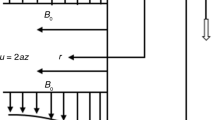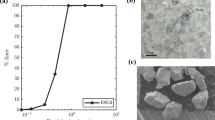Abstract
The development of particle-enriched regions (bed-load) at the base of particle-laden gravity currents has been widely observed, yet the controls and relative partitioning of material into the bed-load is poorly understood. We examine particle-laden gravity currents whose initial mixture (particle and fluid) density is greater than the ambient fluid, but whose interstitial fluid density is less than the ambient fluid (such as occurs in pyroclastic flows produced during volcanic eruptions or when sediment-enriched river discharge enters the ocean, generating hyperpycnal turbidity currents). A multifluid numerical approach is employed to assess suspended load and bed-load transport in particle-laden gravity currents under varying boundary conditions. Particle-laden flows that traverse denser fluid (such as pyroclastic flows crossing water) have leaky boundaries that provide the conceptual framework to study suspended load in isolation from bed-load transport. We develop leaky and saltation boundary conditions to study the influence of flow substrate on the development of bed-load. Flows with saltating boundaries develop particle–enriched basal layers (bed-load) where momentum transfer is primarily a result of particle–particle collisions. The grain size distribution is more homogeneous in the bed-load and the saltation boundaries increase the run-out distance and residence time of particles in the flow by as much as 25% over leaky boundary conditions. Transport over a leaky substrate removes particles that reach the bottom boundary and only the suspended load remains. Particle transport to the boundary is proportional to the settling velocity of particles, and flow dilution results in shear and buoyancy instabilities at the upper interface of these flows. These instabilities entrain ambient fluid, and the continued dilution ultimately results in these currents becoming less dense than the ambient fluid. A unifying concept is energy dissipation due to particle–boundary interaction: leaky boundaries dissipate energy more efficiently at the boundary than their saltating counterparts and have smaller run-out distance.
Similar content being viewed by others
Abbreviations
- \({}^mc_{i}\) :
-
instantaneous velocity of mth phase [m/s]
- \({}^mc_{i}\) :
-
fluctuating velocity of mth phase [m/s]
- \(C_{1\mu}\) :
-
constant in fluid turbulence model (0.09)
- \(C_{1\varepsilon}\) :
-
constant in fluid turbulence model (1.44)
- \(C_{2\varepsilon}\) :
-
constant in fluid turbulence model (1.92)
- \(C_{3\varepsilon}\) :
-
constant in fluid turbulence model (1.22)
- \(C_{\rm D}^{S}\) :
-
drag coefficient
- \({}^mc_{\rm p}\) :
-
heat capacity [J/kg K]
- p d :
-
particle diameter [m] (1.0 × 10−4 m and 0.01 m)
- e :
-
restitution coefficient (0.65)
- \({}^me_{ij}\) :
-
strain rate [s−1]
- F c :
-
coefficient of friction (0.62)
- g i :
-
gravitational acceleration [m/s2] (9.81 m/s2)
- g 0 :
-
radial distribution function
- \(H_{gp}\) :
-
interphase heat transfer [W/m3]
- H 1 :
-
hindrance coefficient in particle–particle drag (0.3)
- \({}^mI_{i}\) :
-
interphase momentum transfer [kg/m 3s]
- \({}^pI_{\rm 2D}\) :
-
second invariant of rate of strain tensor [s−2]
- 1 k :
-
fluctuating kinetic energy of the gas phase [m2/s2]
- m P :
-
pressure [Pa]
- m q :
-
thermal heat flux [J/m2s]
- R km :
-
ratio thermal conductivities
- m T :
-
thermal temperature [K]
- \({}^{m}U_i \) :
-
average velocity [m/s]
- mα:
-
volume fraction of mth phase
- \({}^{m}\varepsilon \) :
-
dissipation rate of fluctuating kinetic energy [m2/s3]
- pκ:
-
granular conductivity [J s /m3]
- pθ:
-
granular temperature [m2/s2]
- \({}^{m}\mu\) :
-
dynamic viscosity [Pa s]
- mλ:
-
bulk viscosity [Pa s]
- \({}^{p}\varphi\) :
-
angle of internal friction (32°)
- Π:
-
turbulence exchange terms
- mρ:
-
density of mth phase [kg/m 3]
- σ k :
-
gas turbulence constant (1.0)
- \(\sigma _{\varepsilon}\) :
-
gas turbulence constant (1.3)
- \({}^{m}\tau _{ij} \) :
-
stress tensor [Pa]
- Preceding superscripts:
-
- m = 1, 2, 3 (1 is gas phase, and 2 and 3 are particle phases):
-
- p = 2 and 3 (particle phases):
-
- Subscripts:
-
- i, j = 1, 2 (indices for spatial direction):
-
References
Benjamin T.B. (1968). Gravity currents and related phenomena. J. Fluid Mech. 31: 209–248
Britter R.E. and Simpson J.E. (1978). Experiments on the dynamics of gravity current head. J. Fluid Mech. 88: 223–240
Hartel C., Meiburg E. and Necker F. (2000). Analysis and direct numerical simulation of the flow at a gravity current head. Part 1 Flow topology and front speed for slip and no-slip boundaries. J. Fluid Mech. 418: 189–212
Necker F., Hartel C., Kleiser L. and Meiburg E. (2002). High-resolution simulations of particle-driven gravity currents. Int. J. Heat Mass Trans. 28: 279–300
Bonnecaze R.T., Huppert H. and Lister J.R. (1993). Particle-driven gravity currents. JFM 250: 339–369
Middleton G.V. (1966). Experiments on density and turbidity currents. Can. J. Earth Sci. 3: 523–637
Carey S. (1996). Pyroclastic flows and surges over water: an example from the 1883 Krakatau eruption. Bull. Volcanol. 57: 493–511
Fisher R.V.e.a. (1993). Mobility of a large-volume pyroclastic flow-emplacement of the Campanian ignimbrite, Italy. J. Volcanol. Geotherm. Res. 56: 262–275
Allen S.R. and Cas R.A.F. (2001). Transport of pyroclastic flows across the sea during explosive, rhyolitic eruption of the Kos Plateau Tuff, Greece. Bull. Volcanol. 62: 441–456
Branney M.J. and Kokelaar P. (2002). Pyroclastic Density Currents and the Sedimentation of Ignimbrites. The Geological Society, London
Freundt, A.: Entrance of hot pyroclastic flows into the sea:experimental observation. Bull. Volcanol. 65 (2003)
Burgisser A., Bergantz G.W. and Breidenthal R.E. (2005). Addressing complexity in laboratory experiments: the scaling of dilute multiphase flows in magmatic systems. J. Volcanol. Geotherm. Res. 141: 245–265
Parsons, J.D.: Civil Engineering vol. 258. University of Illinois, Urbana–Champaign (1998)
Gera D., Syamlal M. and O’Brien T.J. (2004). Hydrodynamics of particle segregation in fluidized beds. Int. J. Multiphase Flow 30: 419–428
Harlow F.H. and Amsden A.A. (1975). Numerical calculation of multiphase flow. J. Comput. Phys. 17: 19–52
Syamlal, M.: National Technical Information Service. Springfield, VA (1987)
Drew D.A. (1983). Mathematical modeling of two-phase flow. Ann. Rev. Fluid Mech. 15: 261–291
Agrawal K., Loezos P.N., Syamlal M. and Sundaresan S. (2001). The role of meso-scale structures in rapid gas-solid flows. J. Fluid Mech. 445: 151–185
Dartevelle S., Rose W.I., Stix J., Kelfoun K. and Vallance J.W. (2004). Numerical modeling of geophysical. granular. flows: 2. Computer simulations of plinian clouds and pyroclastic flows and surges. GEOCHEMI. GEOPHYS. GEOSYST. 5: 1–36
Dufek J.D. and Bergantz G.W. (2005). Transient two-dimensional dynamics in the upper conduit of a rhyolitic eruption: A comparison of the closure models for the granular stress. J. Volcanol. Geotherm. Res. 143: 113–132
Neri A. and Dobran F. (1994). Influence of eruption parameters on the thermofluid dynamics of collapsing volcanic columns. JGR 99(11): 833–11857
O’Brien, T.J., Syamlal, M.: Advances in Fluidized Systems. In: Gaden, E.L., Weimer, A.W.: 127–136 (AIChE Symposium Series, pp. 127–136 (1991)
Parsons J.D. and Garcia M.H. (1998). Similarity of gravity current fronts. Phys. Fluids 10: 3209–3213
Richardson J.F. and Zaki W.N. (1954). Sedimentation and fluidization: Part I. Trans. Inst. Chem. Eng. 32: 35–53
Khan A.R. and Richardson J.F. (1987). The resistance of motion of a solid sphere in a fluid. Chem. Eng. Commun. 62: 135–150
Martin D. and Nokes R. (1988). Crystal settling in a vigorously convecting magma chamber. Nature 332: 534–536
Hazen A. (1904). On sedimentation. Trans. Am. Soc. Civil Eng. LIII: 45–71
Crowe C.T., Gore R.A. and Troutt T.R. (1985). Particle dispersion in free shear flows. Part. Sci. Tech. 3: 149–158
Raju N. and Meiburg E. (1995). The accumulation and dispersion of heavy particles in forced two-dimensional mixing layers. Part 2: The effect of gravity. Phys. Fluids 7: 1241–1264
Burgisser A. and Bergantz G.W. (2002). Reconciling pyroclastic flow and surge: the multiphase physics of pyroclastic density currents. EPSL 202: 405–418
Lun C.K.K., Savage S.B., Jeffrey D.J. and Chepuniy N. (1984). Kinetic theories for granular flow: inelastic particles in Couette flow and slighty inelastic particles in a general flow field. J. Fluid Mech. 140: 223–256
Benyahia S., Syamlal M. and O’Brien T.J. (2005). Evaluation of boundary conditions used to model dilute, turbulent gas/solids flows in a pipe. Powder Technol. 156: 62–72
Jones, N.E.: An experimental investigation of particle size distribution effects in dilute gas–solid flow. PhD Thesis, Purdue University (2001)
Syamlal, M.: review of stress constitutive relation. (Technical Report DOE/MC/21353–2372) Department of Energy, Springfield, VA (1987)
Savage S.B. (1998). Analyses of slow high-concentration flows of granular materials. JFM 377: 1–26
Simonin, O.: Continuum modeling of dispersed two-phase flows. Combustion and Turbulence in Two-Phase Flows, Lecture Series vol. 2. Von Karman Institute of Fluid Dynamics, Rhade Saint Genèse (1996)
Peirano E. and Leckner B. (1998). Fundamentals of turbulent gas-solid flows applied to circulating fluidized bed combustion. Prog. Energy Combust. Sci. 24: 259–296
Cao J. and Ahmadi G. (1995). Gas-particle 2-phase turbulent-flow in a vertical duct. Int. J. Multiphase Flow 21: 1203–1228
Lowe R.J., Linden P.F. and Rottman J.W. (2002). A laboratory study of the velocity structure in an intrusive gravity current. J. Fluid Mech. 456: 33–48
Syamlal, M., Rogers, W., O’Brien, T.J.: MFIX Documentation: Theory Guide, pp. 1–49. US Department of Energy, Morgantown, WV (1993)
Gunn D.J. (1978). Transfer of heat or mass to particles in fixed and fluidized beds. Int. J. Heat Mass Trans. 21: 467–476
Fedors R.F. and Landel R.F. (1979). An empirical method of estimating the void fraction in mixtures of uniform particles of different size. Powder Technol. 23: 225–231
Johnson P.C. and Jackson R. (1987). Frictional–collisional constitutive relations for granular materials, with application to plane shearing. J. Fluid Mech. 176: 67–93
Iverson R.M. (1997). The physics of debris flows. Rev. Geophys. 35: 245–296
Sommerfeld M. (2003). Analysis of collision effects for turbulent gas-particle flow in a horizontal channel: Part 1. particle transport. Int. J. Multiphase Flow 29: 675–699
Yamamoto Y., Potthoff M., Tanaka T., Kajishima T. and Tsuji Y. (2001). Large-eddy simulation of turbulent gas-particle flow in a vertical channel: effect of considering inter-particle collisions. J. Fluid Mech. 442: 303–334
Dade W.B. and Huppert H.E. (1995). Runout and fine-sediment deposits of axisymmetric turbidity currents. J. Geophys. Res. 100: 18597–18609
Dade W.B. (2003). The emplacement of low-aspect ratio ignimbrites. J. Geophys. Res. 108: 2211
Dingman S.L. (1984). Fluvial hydrology. Freeman, New York
Ghosh J.K., Mazumder B.S., Saha M.R. and Sengupta S. (1986). Deposition of sand by suspension currents: Experimental and theoretical studies. J. Sediment. Petrol. 56: 57–66
Valentine G.A. (1987). Stratified flow in pyroclastic surges. Bull. Volcanol. 49: 616–630
Choux C.M. and Druitt T.H. (2002). Analogue study of particle segregation in pyroclastic density currents, with implications for the emplacement mechanisms of large ignimbrites. Sedimentology 49: 907–928
Burgisser A. (2004). Physical volcanology of the 2050 BP caldera-forming eruption of Okmok Volcano, Alaska. Bull. Volcanol. 67: 497–525
Brown R.J. and Branney M.J. (2004). Bypassing and diachronous deposition from density currents: evidence from a giant regressive bed form in the Poris ignimbrite, Tenerife, Canary Islands. Geology 32: 445–448
Author information
Authors and Affiliations
Corresponding author
Additional information
Communicated by H.J.S. Fernando.
Rights and permissions
About this article
Cite this article
Dufek, J., Bergantz, G.W. Suspended load and bed-load transport of particle-laden gravity currents: the role of particle–bed interaction. Theor. Comput. Fluid Dyn. 21, 119–145 (2007). https://doi.org/10.1007/s00162-007-0041-6
Received:
Accepted:
Published:
Issue Date:
DOI: https://doi.org/10.1007/s00162-007-0041-6




